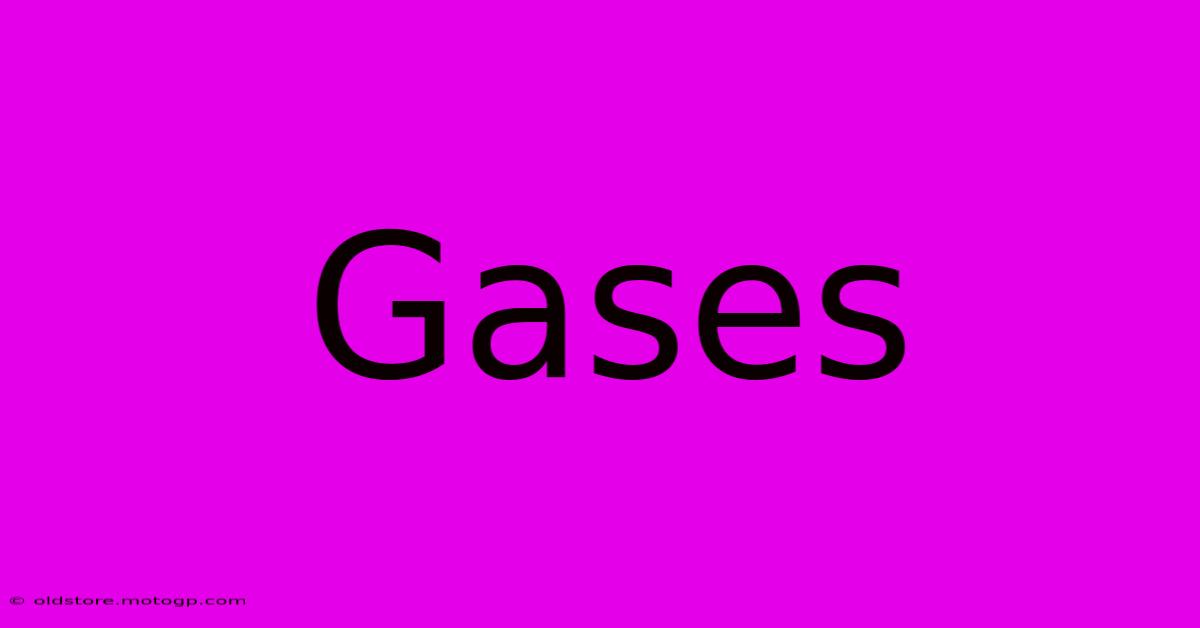Gases

Table of Contents
Understanding Gases: Properties, Behaviors, and Applications
Gases are all around us, forming the air we breathe and playing crucial roles in countless natural and industrial processes. Understanding their properties and behaviors is fundamental to many scientific disciplines, from atmospheric science to chemical engineering. This comprehensive guide explores the fascinating world of gases, delving into their unique characteristics and diverse applications.
What are Gases?
Gases are one of the four fundamental states of matter (along with solids, liquids, and plasmas). Unlike solids and liquids, gases have no definite shape or volume. They are characterized by their ability to expand to fill any container they occupy and are easily compressed. This is due to the weak intermolecular forces between gas particles, allowing them to move freely and independently.
Key Properties of Gases
Several key properties define the behavior of gases:
- Pressure: The force exerted by gas molecules per unit area on the walls of their container. Measured in units like atmospheres (atm), Pascals (Pa), or millimeters of mercury (mmHg).
- Volume: The amount of space occupied by a gas. Measured in liters (L) or cubic meters (m³).
- Temperature: A measure of the average kinetic energy of gas molecules. Measured in Kelvin (K), Celsius (°C), or Fahrenheit (°F).
- Amount (moles): The number of gas particles present, typically expressed in moles (mol).
Gas Laws: Governing Gas Behavior
The behavior of gases is governed by several fundamental laws, which relate the pressure, volume, temperature, and amount of a gas:
- Boyle's Law: At constant temperature, the volume of a gas is inversely proportional to its pressure (V ∝ 1/P). If you increase the pressure on a gas, its volume decreases, and vice versa.
- Charles's Law: At constant pressure, the volume of a gas is directly proportional to its temperature (V ∝ T). As temperature increases, the volume of a gas expands, and as temperature decreases, the volume contracts.
- Gay-Lussac's Law: At constant volume, the pressure of a gas is directly proportional to its temperature (P ∝ T). An increase in temperature leads to an increase in pressure, and vice versa.
- Avogadro's Law: At constant temperature and pressure, the volume of a gas is directly proportional to the number of moles of gas (V ∝ n). More gas molecules mean a larger volume.
- Ideal Gas Law: Combines Boyle's, Charles's, and Avogadro's laws into a single equation: PV = nRT, where R is the ideal gas constant. This law provides a good approximation of gas behavior under many conditions.
Deviations from Ideal Gas Behavior
The ideal gas law is a simplification. Real gases deviate from ideal behavior, especially at high pressures and low temperatures. This is because intermolecular forces become more significant under these conditions, affecting the gas molecules' interactions.
Types of Gases
Gases can be categorized in several ways:
- Noble Gases: Inert, monatomic gases (Helium, Neon, Argon, Krypton, Xenon, Radon) that rarely react with other elements.
- Diatomic Gases: Gases existing as two atoms bonded together (Oxygen, Nitrogen, Hydrogen, Chlorine, Fluorine, Bromine, Iodine).
- Polyatomic Gases: Gases composed of more than two atoms (Carbon Dioxide, Methane, Ammonia).
Applications of Gases
Gases play vital roles in numerous applications:
- Atmosphere: The Earth's atmosphere is a mixture of gases essential for life.
- Industrial Processes: Gases are used extensively in manufacturing, such as in the production of ammonia (Haber-Bosch process) and other chemicals.
- Energy Production: Natural gas is a significant energy source, and gases are also used in various power generation technologies.
- Medical Applications: Gases like oxygen are vital in medical treatments and healthcare.
- Refrigeration and Air Conditioning: Certain gases are used as refrigerants.
Conclusion
Gases are fundamental to our understanding of the physical world and have countless applications across various industries. From the air we breathe to the industrial processes that shape our society, gases play a critical role. A comprehensive understanding of their properties, behaviors, and governing laws is crucial for addressing challenges and developing innovative solutions in diverse fields.

Thank you for visiting our website wich cover about Gases. We hope the information provided has been useful to you. Feel free to contact us if you have any questions or need further assistance. See you next time and dont miss to bookmark.
Featured Posts
-
Transform Your Nails Overnight The Gel Bottle Biab Your Ultimate Nail Savior
Feb 05, 2025
-
Unraveling The Cinematic Illusion How Side Lighting Crafts Atmosphere
Feb 05, 2025
-
Thwack Crush Your Storytelling Goals With Our Titan Like Comic Strip Template
Feb 05, 2025
-
Sweden Shooting Multiple Dead At Center
Feb 05, 2025
-
Martin Trade Sixers Take A Chance
Feb 05, 2025
